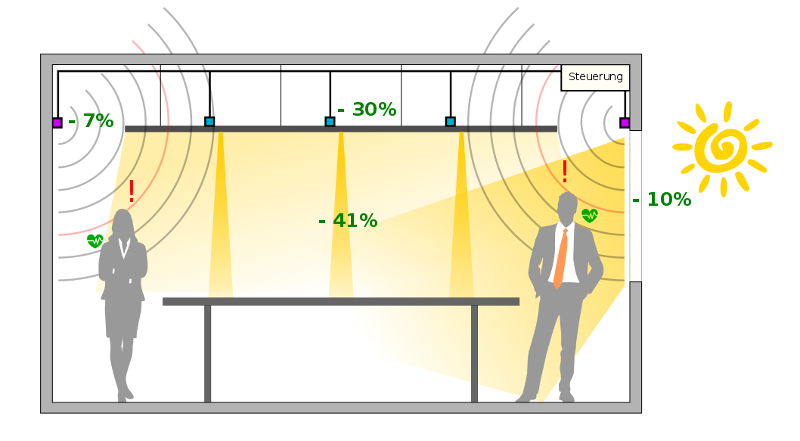LessIsMore - Energy efficient human centric lighting by innovative components and daylight integration
Short Description
Status
completed (Februar 2023)
Starting point, contents and results
The building sector accounts for around one third of the world's energy requirements and thus also a correspondingly high proportion of greenhouse gas emissions. Since artificial lighting, with its focus on commercial buildings, accounts for a significant share of these emissions, and the use of artificial lighting is also linked to the necessary cooling loads, an increase in efficiency in the area of lighting is proving to be essential for reducing global energy consumption.
In addition, light also has a significant influence on both thermal and visual comfort, and in modern lighting designs, non-visual effects of light are frequently targeted, as they can contribute to improved concentration in the short term and to health aspects such as stabilization of the circadian rhythm or improved sleep in the long term.
However, lighting concepts created in this area of conflict are not easy to define, since the requirements of the individual aspects are often contrary to each other. For example, the illuminance levels required to provide non-visual effects go far beyond the normative minimum specifications, can also contribute to negative visual comfort if strictly adhered to, and generally have a negative impact on the energy balance of the overall system. In contrast, however, health-promoting measures cannot be provided in the long term should the implemented concept be based on the more positive normative minimum requirements in terms of energy.
With the vision of contributing to a more sustainable and healthier society, the LessIsMore project addresses this challenge with the goal of developing an integral artificial and daylighting control system for energy-efficient human-centric lighting solutions. The development focused primarily on the reduction of existing losses, which result from a careless and inefficient use of the individual lighting components (lighting concept, LED drivers, sensors, control) or are due to a neglected integration of daylight.
To achieve this goal, the fundamental identification of existing energetic potentials was carried out by means of a multimodal approach, in which internationally existing lighting designs were evaluated and basic system components (sensors and driver modules) were systematically investigated. The resulting findings were then used to derive system requirements, which formed the basis of the further development-related project content.
Since energetic and effect-related objectives are fundamentally influenced by different, conflicting factors, the requirements-related developments were carried out with regard to relevant objectives in two different fields of application. On the one hand, non-visual objectives were addressed by means of zoned workplace lighting systems in such a way that the necessary illuminance levels could be implemented in an extremely energy-efficient manner by means of a close user proximity.
The relevant prototypes focused on personalization strategies and accordingly required decentralized control components that were directly integrated into the lighting systems on an ICT basis. On the other hand, a centralized integral artificial lighting and daylighting control logic was developed and implemented in the Bartenbach Living Lab. This subsequently made it possible to evaluate the energy effectiveness of the developed solution under real working conditions. This approach proved to be absolutely necessary, as the effectiveness of lighting controls is generally significantly influenced by both user individualities (such as work structure and presence at the workplace) and the variability of environmental conditions (e.g. weather conditions or daylight availability).
Finally, both development approaches were evaluated within the framework of a structured laboratory study and a longitudinal field study. The field study involved extensive monitoring (by means of about 100 sensors) of building and personal parameters, which allowed a subsequent evaluation of the energy performance in relation to currently existing benchmark values. The laboratory study, on the other hand, with a participation of 58 persons, focused on the systematic, effect-related evaluation of an energetically optimized control approach, in which current approaches to all-day increased light dose were replaced by short-term bright light interventions. Due to COVID-19 related restrictions during the study phase, which resulted in an increased occurrence of home office days, the originally planned evaluation of the health-promoting biological light effect could unfortunately not be implemented.
In the studies conducted, both the intended energetic and effect-related effectiveness of the control approaches developed could be positively evaluated. The laboratory results confirmed both on a subjective level (reduced perceived workload and fatigue) and on an objective level (increased reaction time) the non-visual effect of the short-term light interventions with a constant absence of negative side effects (asthenopic complaints). The long-term monitoring of the Bartenbach Living Lab was also able to demonstrate the energetic positive performance of the developed integral control logic, which with 4.74 kWh/m²a shows a clear effect compared to the benchmark for energy-efficient lighting (10 kWh/m²a). Without the developed daylight-dependent control, the calculated energy demand would be 16.5 kWh/m²a, taking into account the recorded presence profiles.
Accordingly, the results expected in the LessIsMore project could be fully achieved. Nevertheless, real implementations of integral planning still prove to be difficult, since the key performance indicators of lighting systems are highly dependent on individual user characteristics, which in some cases may even extend beyond the actual application area. Therefore, the relevant target criteria are still not clearly definable due to a lack of knowledge and were not addressed in the present research project. As a result, current lighting designs and simulations are based on highly generalized assumptions about user information, which limit the addressing of energetic potentials.
Future research projects, which would aim at decoding user characteristics, could therefore make an extended contribution to achieving environmental and climate policy goals.
Project Partners
Project management
Bartenbach GmbH
Contact Address
Bartenbach GmbH
Rinner Straße 14
A-6071 Aldrans
Tel.: +43 (512) 3338 0
Fax: +43 (512) 3338 88
E-mail: wilfried.pohl@bartenbach.com
Web: www.bartenbach.com

